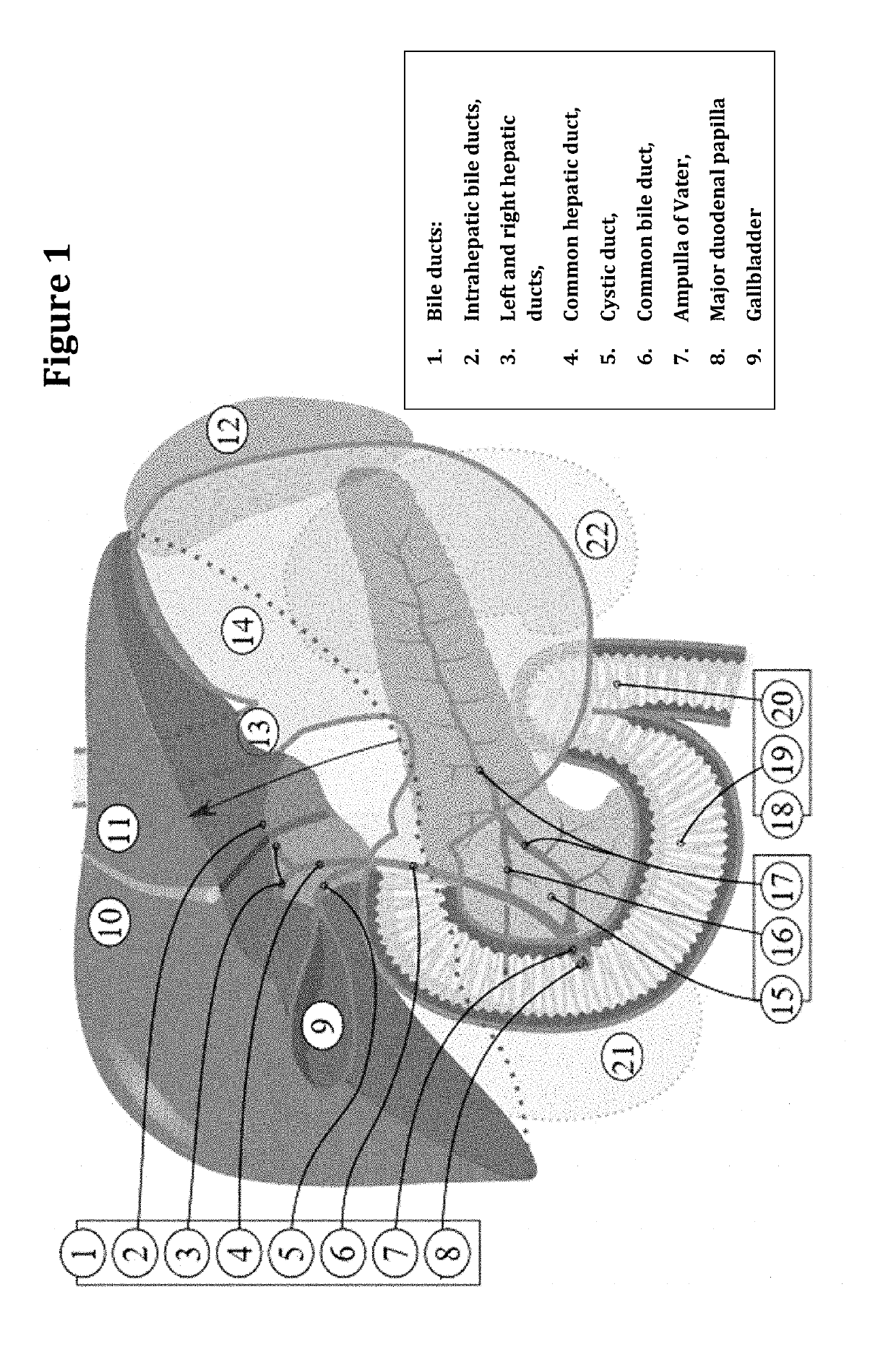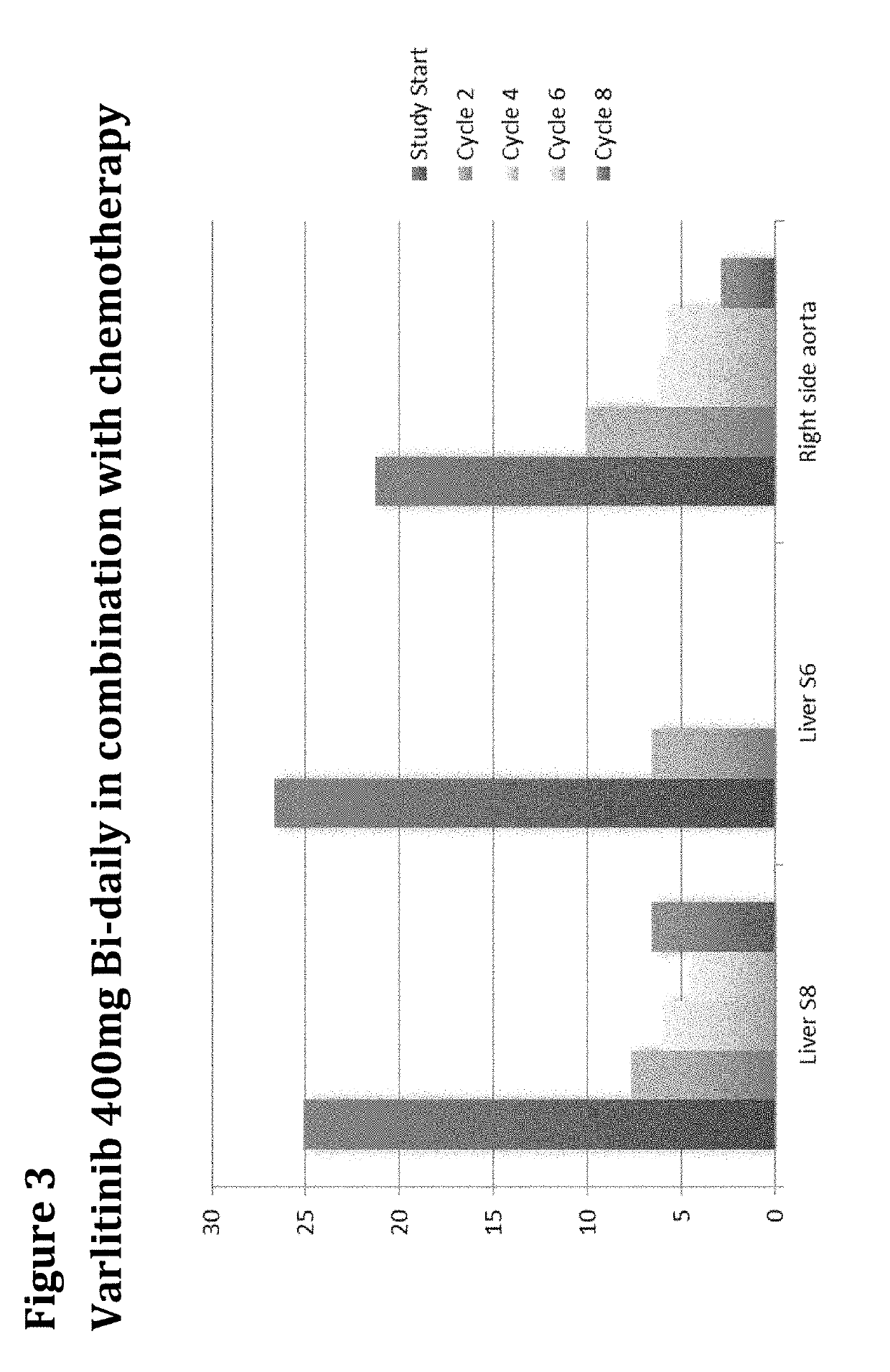Treatment of Biliary Duct Cancer
a biliary duct and cancer technology, applied in the field of biliary duct cancer treatment, can solve the problems of losing efficacy, limiting the therapeutic alternatives that are effective, and treating the patient seems to respond well
- Summary
- Abstract
- Description
- Claims
- Application Information
AI Technical Summary
Benefits of technology
Problems solved by technology
Method used
Image
Examples
example 1
Varlitinib 400 mg Bi-Daily Monotherapy
[0190]A 45 year-old male stage IV cholangiocarcinoma EGFR positive (3+) cancer patient had progressive disease following:[0191]first line treatment with gemcitabine (partial remission), and[0192]second line treatment with cisplatin and 5-FU.
[0193]The results are shown in FIG. 2. After treatment cycle 6 with Varlitinib 400 mg bi-daily the liver tumours decreased in size up to 23% and the tumour marker CA 19-9 fell from ˜900 U / ml to ˜250 U / ml.
example 2
Varlitinib 400 mg Bi-Daily Monotherapy
[0194]A 58 year-old, male, stage IV, extra-hepatic cholangiocarcinoma, prior treatment:[0195]Whipple[0196]Radiotherapy[0197]Gemzar / cisplatin for 6 months
[0198]For the first 6 cycles, the patient received Varlitinib 400 mg BID continuously with cisplatin (80 mg / m2 every 3 weeks) and capecitabine (1000 mg / m2 BID, 2 weeks on, 1 week off). Image scan at the end of cycle 6 showed 85.77% reduction in tumour size. After cycle 6, the patient received varlitinib monotherapy and tumor scan at the end of cycle 8 showed 87% reduction. This patient showed partial remission for 24 weeks. However, at the end of cycle 10, image scan showed tumour enlarged to the extent that met criteria for disease progression based on RECIST (>20% increase against nadir), so the patient was withdrawn from this study. In summary, the patient received varlitinib with chemo for 6 cycles and varlitinib monotherapy for another 4 cycles (3 weeks per cycle).
[0199]The results are show...
example 3
Treatment of Cholangiocarcinoma with Varlitinib 400 mg Bi-Daily Orally and Cisplatin / Capecitabine Combination Chemotherapy
[0200]A 56 year-old male with stage IV cholangiocarcinoma (3 lesions) had progressive disease following treatment with:[0201]radiotherapy, and[0202]gemcitabine (Gemzar®) and cisplatin—6 months.
[0203]After treatment cycle 6 with Varlitinib 400 mg bi-daily, cisplatin and capecitabine the patient showed an 85.77% response, see FIG. 4. No dose limiting toxicity was observed in the first two treatment cycles. Varlitinib was well tolerated. The cisplatin and capecitabine regime was cisplatin 80 mg / m2 IV infusion and capecitabine 1000 mg / m2 orally twice daily for 14 days every 3 weeks.
PUM
| Property | Measurement | Unit |
|---|---|---|
| degree of resistance | aaaaa | aaaaa |
| resistance | aaaaa | aaaaa |
| time | aaaaa | aaaaa |
Abstract
Description
Claims
Application Information
 Login to View More
Login to View More - Generate Ideas
- Intellectual Property
- Life Sciences
- Materials
- Tech Scout
- Unparalleled Data Quality
- Higher Quality Content
- 60% Fewer Hallucinations
Browse by: Latest US Patents, China's latest patents, Technical Efficacy Thesaurus, Application Domain, Technology Topic, Popular Technical Reports.
© 2025 PatSnap. All rights reserved.Legal|Privacy policy|Modern Slavery Act Transparency Statement|Sitemap|About US| Contact US: help@patsnap.com



